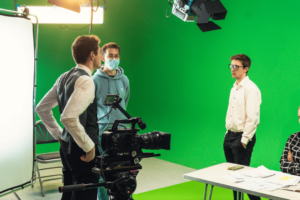Animation software is a versatile digital tool for creating moving images and visual storytelling. Artists and animators can bring characters, objects, and scenes to life through a series of still frames or drawings played rapidly to simulate motion. Whether for entertainment, education, or marketing, animation software provides:
- A platform to unleash creativity.
- Enabling the design of captivating animations, from traditional hand-drawn styles to sophisticated computer-generated graphics, by offering a range of tools and features for precise control over movement.
- Timing.
- Visual effects.

What is Animation?
Animation is both an art form and a technical process that involves crafting the illusion of movement by rapidly displaying a series of static images or frames in succession. It is a versatile medium used in various industries, including entertainment, education, advertising, and gaming, to convey stories, ideas, and information dynamically and engagingly. Animations can take many forms, from traditional hand-drawn or stop-motion animations to computer-generated 3D graphics, and they play a crucial role in visual storytelling, enhancing user experiences, and conveying complex concepts through the manipulation of visuals, timing, and movement.
Defining Animation Software
Animation software refers to specialized digital tools that enable artists, designers, and animators to create, edit, and manipulate visual elements to produce animated sequences. These software applications provide a platform for crafting moving images and storytelling by allowing users to design and control characters, objects, and scenes’ movement, timing, and appearance. Animation software comes in various forms, catering to various animation techniques, from 2D traditional animations to complex 3D computer-generated imagery (CGI). These tools empower creators to bring their imaginative ideas to life, making animation a powerful medium for entertainment, education, advertising, and more.

What is Animation Software Used For?
Animation software creates dynamic and visually captivating animations, allowing artists, designers, and animators to craft moving images and sequences. It is employed across various industries to bring characters, objects, and scenes to life, including entertainment, advertising, education, and gaming. Animation software provides tools for controlling movement, timing, and visual effects, making it a versatile medium for storytelling, explaining complex concepts, enhancing user experiences, and unleashing creative expression. Whether producing 2D hand-drawn animations, sophisticated 3D graphics, or special effects, animation software is vital for professionals and enthusiasts to convey ideas, emotions, and narratives through motion.
What are Types of Software Animation?
Various types of animation software are available, each catering to different animation techniques and user preferences. Here are some common types of animation software:
2D Animation Software
- Traditional Animation Software: Tools like Toon Boom Harmony and TVPaint offer features for hand-drawn frame-by-frame animation.
- Vector Animation Software: Adobe Animate (formerly Flash) is used for vector-based 2D animations.
3D Animation Software
- Character Animation: Software like Autodesk Maya, Blender, and Cinema 4D are popular for creating 3D character animations.
- 3D Modeling and Rendering: Software such as Autodesk 3ds Max and Rhino are used to model and render 3D animations.
- Motion Graphics: Adobe After Effects combines 2D and 3D elements for motion graphics and visual effects.
Stop-Motion Animation Software
These tools assist in creating stop-motion animations, where physical objects are moved incrementally and photographed frame by frame. Dragonframe is a notable example.
Motion Graphics Software
Applications like Adobe After Effects and Apple Motion specialize in creating motion graphics, visual effects, and animated typography.
Whiteboard Animation Software
Tools like VideoScribe and Doodly allow users to create whiteboard-style animations, often used for educational or explainer videos.
Web-Based Animation Tools
Certain animation software operates entirely through web browsers, granting accessibility from any device with an internet connection. Notable examples encompass Vyond and Moovly.
Game Development Engines
Unity and Unreal Engine have animation capabilities, making them essential for creating interactive 3D animations and games.
Open Source Animation Software
Blender is a notable open-source software that offers 3D modeling, animation, rendering, and more.
Specialized Animation Software
Certain software is designed for specific purposes, such as Anime Studio for creating anime-style animations and Toonz for professional 2D animation.
Storyboarding Software
While not animation software per se, storyboard tools like Storyboard Pro help create pre-visualization for animations and films.
The choice of animation software depends on the project’s specific needs, the animation style you want to create, your skill level, and your budget. Many professionals use a combination of software tools to achieve their desired results, as each software has its strengths and weaknesses.
Why Use Animation Software?
Animation software is used for several compelling reasons. Firstly, it enables the creation of visually engaging content that captures attention and communicates ideas effectively. Whether it’s for entertainment, education, marketing, or training, animations can convey complex concepts in a more accessible and memorable way.
Secondly, animation software offers precise control over movement, timing, and visual effects, allowing artists and designers to bring their creative visions to life. This level of control is especially valuable in industries like filmmaking, game development, and advertising, where attention to detail is crucial.
Moreover, animation software enhances the production process, increasing efficiency and cost-effectiveness compared to conventional methods. It facilitates asset reuse and the swift refinement of concepts, resulting in time and resource savings.
Finally, animation software accommodates a wide range of animation techniques, including 2D, 3D, stop-motion, and motion graphics, showcasing its versatility and ability to meet diverse project needs. In conclusion, animation software stands as a potent tool for storytelling, visual communication, and artistic expression, rendering it a valuable resource across numerous professional domains.
Things to Consider While Using Animation Software
When using animation software, there are several important factors to consider to ensure a successful animation project:
Purpose and Audience
Clearly define the purpose of your animation and understand your target audience. Different styles and techniques may be more effective for different audiences and messages.
Storyboarding
Create a detailed storyboard or animatic to plan your animation’s sequence and timing. This helps you visualize the flow of your animation before you start the detailed work.
Animation Techniques
Choose the appropriate animation technique, whether 2D,3D, stop-motion or a combination. Each technique has its requirements and capabilities.
Software Selection
Software Choice: Choose the appropriate animation software based on your requirements. Take into account factors such as your skill level, budget, and the specific features needed for your project.
Assets and Resources
Gather or create all the necessary assets, such as character designs, backgrounds, and sound effects, before starting the animation process.
Timing and Pacing
Pay careful attention to the timing and pacing of your animation. Properly timed movements and actions can significantly impact the storytelling and overall impact.
Keyframes and In-Betweens
Understand the concept of keyframes and in-between frames. Keyframes define major poses or actions, while in-betweens fill in the motion between keyframes.
Sound and Music
If applicable, plan and incorporate sound effects and music. Sound enhances the viewer’s experience and can convey emotions and atmosphere.
Testing and Iteration
Regularly test your animation as you progress. Make necessary adjustments and enhancements based on feedback and your own observations.
File Management
Organize your project files and assets systematically to avoid confusion and ensure efficient collaboration if you work in a team.
Performance Optimization
If you’re creating animations for the web or mobile apps, optimize your animation for performance by reducing file sizes and considering playback speed.
Export Settings
Understand the export settings of your animation software to ensure that your final output meets your intended requirements in terms of resolution, format, and quality.
Backup and Version Control
Regularly back up your work and consider using version control tools or cloud storage to prevent the loss of important files.
Legal and Copyright
Be aware of copyright and licensing issues when using third-party assets, music, or characters in your animations. Ensure you have the necessary permissions or licenses.
Feedback and Collaboration
Seek feedback from peers, mentors, or clients during creation. Collaboration can lead to valuable insights and improvements. Considering these factors, you can create animations that effectively convey your message, engage your audience, and meet your project’s goals and requirements.
What Makes a Great Animation Software?
Great animation software possesses several key qualities that set it apart:
Ease of Use
A good animation tool is user-friendly, making it accessible to beginners and experienced animators. It should have an intuitive interface and well-documented features.
Diverse Animation Techniques
Versatility is vital. The software should support various animation styles, such as 2D, 3D, stop-motion, and motion graphics, allowing artists to choose the right technique for their projects.
Rich Feature Set
A robust set of features, including drawing tools, rigging, keyframe animation, and rendering options, is crucial. It should cater to the diverse needs of animators.
Performance
Animation software should run smoothly even when handling complex projects, preventing lag or crashes that can disrupt workflow.
Asset Reusability
Reusing assets like character rigs, backgrounds, or props saves time and streamlines production.
Compatibility
Compatibility with popular file formats and the ability to import/export assets easily facilitate collaboration and integration with other software.
Cost and Licensing
Affordability is essential, but software quality should not be compromised. Additionally, flexible licensing options, such as one-time purchases or subscription models, accommodate different budgets.
Support and Updates
Responsive customer support and regular software updates ensure that issues are resolved and the software stays current.
Community and Resources
A thriving user community and available learning resources, such as tutorials and forums, aid in mastering the software.
Stability and Reliability
Consistency and reliability in performance and rendering are critical for delivering high-quality animations.
Customization
The ability to customize the workspace and tools can enhance an animator’s workflow.
Rendering Capabilities
High-quality rendering options, including lighting and texture effects, are essential for creating realistic animations.
What is Animation Software Engineering?
Animation software engineering is a specialized field of software development focused on designing, building, and maintaining software applications tailored for animation creation. Animation software engineers work on developing user-friendly interfaces, optimizing performance for real-time rendering, integrating with other tools, ensuring cross-platform compatibility, and enabling interactive and collaborative features. They also address security concerns and continually update and maintain the software to provide animators and artists with powerful tools to bring their creative visions to life through various animation techniques, from 2D animations to complex 3D simulations.
A Few Popular Animation Software
A few popular animation software programs widely used in the animation industry:
Adobe Animate (formerly Flash)
A versatile 2D animation and multimedia authoring tool often used for web animations, character animations, and interactive content.
Toon Boom Harmony
A professional-grade 2D animation software known for its capabilities in traditional frame-by-frame animation and rigging for character animation.
Autodesk Maya
A comprehensive 3D animation software used in film, television, and game development for character modeling, rigging, animation, and rendering.
Blender
An open-source 3D animation software that provides an extensive array of capabilities, encompassing 3D modeling, rigging, sculpting, animation, and rendering.
Adobe After Effects
Primarily used for motion graphics and visual effects, After Effects combines 2D and 3D elements to create compelling animations and video effects.
Cinema 4D
A 3D modeling and animation software, frequently preferred by motion graphics artists due to its intuitive interface and robust toolset.
Dragonframe
A stop-motion animation software designed specifically for stop-motion artists, providing precise control over frame-by-frame animations.
Moho (formerly Anime Studio)
A 2D animation software known for its bone-based rigging system, making character animation more efficient and accessible.
Autodesk 3Ds Max
Primarily used for 3D modeling, rendering, and animation, 3ds Max is popular in architectural visualization, game development, and visual effects.
Pencil2D
An open-source, user-friendly 2D animation software suitable for traditional hand-drawn animation and basic digital animation projects.
Toonz
A 2D animation software used for traditional hand-drawn animation, often associated with creating animated cartoons.
Adobe Character Animator
A component of the Adobe Creative Cloud suite, this software focuses on real-time character animation, especially for live broadcasts and interactive media.
Unity
While primarily a game development engine, Unity also features animation tools for creating interactive 2D and 3D animations and experiences.
Unreal Engine
Like Unity, Unreal Engine is primarily used for game development but offers animation capabilities and is commonly used for creating interactive 3D animations and experiences.
These are just a few examples, and the choice of animation software depends on your specific needs, style, and budget. Many professionals use a combination of these tools to achieve the desired results.
What is 3D Animation Software?
3D animation software is a digital tool that allows artists, designers, and animators to create three-dimensional moving images and visual content. It enables the modeling, rigging, animation, and rendering of 3D characters, objects, and environments. This software is widely used in industries like film, video games, architectural visualization, and product design to produce realistic and immersive animations, offering a range of features for precise control over motion, lighting, and visual effects, ultimately bringing virtual worlds to life with depth and realism.
What is Adobe Animate?
Adobe Animate is a versatile multimedia authoring and animation software developed by Adobe Inc. It’s primarily used to create interactive web content, including animations, games, and interactive media. Formerly known as Flash, Adobe Animate allows users to design and animate vector graphics and characters, incorporating interactivity and scripting to create engaging online experiences. It’s popular for web designers, animators, and multimedia developers seeking to produce visually appealing and interactive content for web and mobile platforms.
How Animation Software Helps to Make Your Content Standout?
Animation software plays a pivotal role in making your content stand out in several ways:
Visual Engagement
Animation adds movement and life to your content, capturing the viewer’s attention and making it more engaging. Dynamic visuals are more likely to be noticed and remembered.
Storytelling
Animation is an effective storytelling tool. It enables you to visually communicate intricate ideas and stories in a compelling and concise manner, enhancing the accessibility and memorability of your message.
Creativity and Originality
Animation software enables you to unleash your creativity, allowing you to create unique and imaginative content that sets you apart from competitors. You have complete control over the visual style and aesthetics.
Complex Concepts Simplified
Animation simplifies the communication of intricate concepts. It simplifies intricate information into easily understandable visuals, aiding your audience in comprehending and retaining the information.
Emotional Connection
Animation can evoke emotions and feelings through visuals, characters, and storytelling. This emotional connection can make your content more relatable and impactful.
Versatility
Animation software accommodates various animation techniques and styles, from 2D to 3D, stop-motion to motion graphics. This versatility lets you choose the style that best suits your content and target audience.
Interactivity
Many animation tools enable you to create interactive content, encouraging viewer engagement and participation. Interactive animations can boost user retention and satisfaction.
Brand Recognition
Consistent and well-crafted animations can reinforce your brand identity. Animated logos, characters, or branding elements can make your content instantly recognizable.
Visual Appeal
High-quality animations with smooth transitions, attention to detail, and aesthetically pleasing visuals can enhance the overall look and feel of your content, making it more appealing to your audience.
Competitive Advantage
Animation can give you an edge in a crowded digital landscape. Well-executed animations can make your content more memorable and shareable, increasing its reach and impact.
Demonstrations and Tutorials
Animation is a powerful tool for creating product demonstrations and instructional tutorials. It allows you to showcase your product or service’s features and benefits effectively.
Entertainment Value
Animation can add an element of entertainment to your content, making it enjoyable and shareable. This can result in heightened viewer engagement and increased social sharing.
In summary, animation software empowers you to transform your content into visually compelling, informative, and emotionally engaging experiences. By leveraging animation effectively, you can make your content stand out, connect with your audience on a deeper level, and achieve your communication goals more effectively.
Best Animation Software in 2023
- Adobe Animate
- Canva Animator
- Mango Animate
- Autodesk Maya
- Adobe Character Animator
- Blender
- Moho Pro
- Houdini
- Cinema 4D
- Pencil 2D
- CelAction 2D
- Cartoon Animator 4
- Visme
- Crello
Videos
15 BEST 2D ANIMATION SOFTWARE IN 2024
Best 3D Animation Software to Learn
Dreamworks Open Sourcing Their Animation Software – YouTube
This NEW A I Animation Software Is INSANE
FREE Animation Software in 2023 – FOR BEGINNERS
How To Animate For Free On Computer












